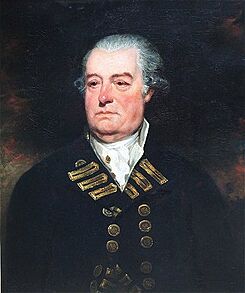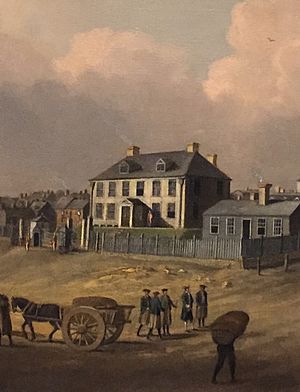Mariot Arbuthnot facts for kids
Quick facts for kids
Mariot Arbuthnot
|
|
|---|---|
 |
|
| Born | 1711 Weymouth |
| Died | 31 January 1794 (aged 82–83) London |
| Allegiance | Kingdom of Great Britain |
| Service/ |
Royal Navy |
| Rank | Admiral of the Blue |
| Battles/wars | Battle of Cape Henry |
| Relations | John Arbuthnot (uncle) |
Admiral Mariot Arbuthnot (1711 – 31 January 1794) was a British admiral. He was an important leader in the Royal Navy during the American War for Independence, especially in North America.
Contents
Mariot Arbuthnot was born in Weymouth, England, in 1711. His father was Robert Arbuthnot. Mariot joined the Royal Navy in the late 1720s. He became a lieutenant in 1739 and a commander in 1746.
In 1746, he commanded a small warship called HMS Jamaica. While on patrol, his ship captured two French privateers. These were private ships allowed by a government to attack enemy ships. In 1747, he became a post captain, which meant he was in charge of a warship. He then commanded the frigate HMS Surprize and later Triton.
Serving in the Seven Years' War
In 1757, Arbuthnot became the chief officer of Garland. During the Seven Years' War, in 1759, he commanded Portland. This ship was part of a group that blocked the French fleet in Quiberon Bay. He was there when the French fleet was completely defeated on November 20. Later in the war, he commanded HMS Oxford. In 1770, he was made captain of HMS Terrible.
Role in the American War of Independence
From 1775 to 1778, Mariot Arbuthnot was the main Navy official in Halifax, Nova Scotia. He also served as the Lieutenant Governor of Nova Scotia during this time.
In 1779, he was promoted to Vice-Admiral of the Blue. He then took command of HMS Europa. That same year, he became the commander-in-chief of the British Navy's ships in North America. Soon after he arrived, a French fleet under Count d'Estaing trapped his ships in New York City harbor.
In December 1779, Arbuthnot helped transport soldiers led by Sir Henry Clinton to Charleston, South Carolina. He worked with Clinton to surround and attack the city in what was known as the Siege of Charleston. Important citizens of Charleston signed a document surrendering the city to Arbuthnot and Clinton.
On September 26, 1780, he was promoted again to Vice-admiral of the White. On March 13, 1781, he fought against a French fleet near Newport at the Battle of Cape Henry. After this battle, he returned to England.
Later Life and Family
Mariot Arbuthnot continued to advance in rank. On February 1, 1793, he became Admiral of the Blue. He passed away in London the following year, on January 31, 1794. He had two sons, John and Charles.
Admiral Arbuthnot was the nephew of Dr. John Arbuthnot, who was a famous writer and mathematician.


